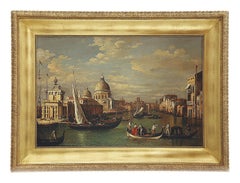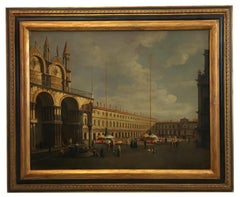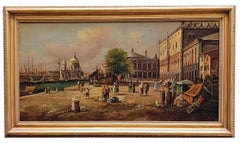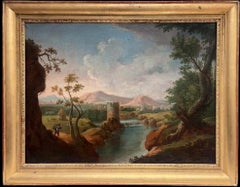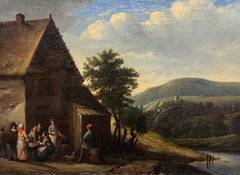Mario De Angeli Landscape Paintings
to
1
3
Overall Width
to
Overall Height
to
4
2
4
3
1
1
4
4
4
4
3
4
669
600
314
229
4
1
4
Artist: Mario De Angeli
VENICE -In the Manner of Canaletto- Italian Landscape Oil on Canvas Painting
By Mario De Angeli
Located in Napoli, IT
Venice - Mario De Angeli - Italia 2009 - Oil on canvas cm. 80x120.
Gold leaf gilded wooden frame ext. mis. cm.100x140
Mario De Angeli's canvas is an extraordinary work of Italian l...
Category
Early 2000s Old Masters Mario De Angeli Landscape Paintings
Materials
Gold Leaf
VENICE - In the Manner of Canaletto -Italian Landscape Oil on Canvas Painting
By Mario De Angeli
Located in Napoli, IT
Venice - Mario De Angeli - Italia 2006 - Oil on canvas cm. 70x90.
Mario De Angeli's canvas is an extraordinary work of Italian landscape painting. They are inspired by the landscap...
Category
Early 2000s Old Masters Mario De Angeli Landscape Paintings
Materials
Canvas, Oil
VENICE - In the Manner of Canaletto -Italian Landscape Oil on Canvas Painting
By Mario De Angeli
Located in Napoli, IT
Venice - Mario De Angeli - Italia 2008 - Oil on canvas cm. 75x150.
Mario De Angeli's canvas is an extraordinary work of Italian landscape painting.
They are inspired by the landsc...
Category
Early 2000s Italian School Mario De Angeli Landscape Paintings
Materials
Gold Leaf
VENICE-In the Manner of Canaletto - Italian Landscape Oil on Canvas Painting
By Mario De Angeli
Located in Napoli, IT
Venice - Mario De Angeli - Italia 2008 - Oil on canvas cm. 60x120.
Mario De Angeli's canvas is an extraordinary work of Italian landscape painting.
They are inspired by the landsc...
Category
Early 2000s Italian School Mario De Angeli Landscape Paintings
Materials
Gold Leaf
Related Items
Very Large 18th Century French Romantic Classical Landscape Figure in Roman View
Located in Cirencester, Gloucestershire
The Roman Landscape
French artist, .late 18th century
oil on canvas, framed in antique gilt frame
framed: 35.5 x 45.5 inches
canvas: 29 x 39 inches
Provenance: private collection, Fr...
Category
Late 18th Century Italian School Mario De Angeli Landscape Paintings
Materials
Canvas, Oil
$2,193 Sale Price
20% Off
H 35.5 in W 45.5 in
Figures Chatting outside Village Tavern in Mountain Landscape, Period Oil
By 19th century Dutch or Flemish school
Located in Cirencester, Gloucestershire
Dutch/ Flemish School, early 1800's
oil on canvas, framed
framed: 19 x 24 inches
canvas: 13.5 x 18.5 inches
provenance: private collection, France
condition: good and sound condition...
Category
Early 19th Century Old Masters Mario De Angeli Landscape Paintings
Materials
Oil, Canvas
$1,428 Sale Price
20% Off
H 19 in W 24 in
Fine 17th Century Dutch Old Master Oil Military Encampment Figures on Horseback
By Philips Wouwerman
Located in Cirencester, Gloucestershire
The Military Encampment
Dutch School, 17th century
circle of Philips Wouwermans (Dutch 1619-1668)
oil painting on canvas, in 18th century gilt frame
canvas measures: 19.5 x 17 inches...
Category
17th Century Old Masters Mario De Angeli Landscape Paintings
Materials
Oil, Canvas
$4,356 Sale Price
20% Off
H 27 in W 24 in D 2 in
Large 17th century Italian old master - Noli me tangere, Christ in the garden
By Pier Francesco Cittadini
Located in Aartselaar, BE
Large 17th Century Italian Old Master, The Garden - Noli me tangere, Pier Francesco Cittadini (attr.)
Description
In the stillness of a garden in bloom, Noli me tangere captures a p...
Category
17th Century Old Masters Mario De Angeli Landscape Paintings
Materials
Canvas, Oil
$10,717
H 31.89 in W 40.56 in
Antique English Grand Tour Old Master Oil Figures Classical Arcadian Landscape
Located in Cirencester, Gloucestershire
Classical Landscape
English School, early 19th century, unsigned
oil on canvas, framed
framed: 29 x 37 inches
canvas : 19 x 27 inches
Provenance: private collection, UK
Condition: th...
Category
Early 19th Century Old Masters Mario De Angeli Landscape Paintings
Materials
Oil, Canvas
$2,702 Sale Price
20% Off
H 29 in W 37 in
Dramatic Italian Landscape oil painting - listed artist Angiola Meucci 1880-1966
Located in Baltimore, MD
This is a colorful mountainous view in what is likely Northern Italy. Angiola Meucci captured a dramatic sunrise or sunset to play off the verdant green mountain side in the foreground. The fencing and the pathway lead one through this breathtaking landscape that undoubtedly offers stunning views...
Category
1920s Italian School Mario De Angeli Landscape Paintings
Materials
Oil
$1,275
H 13 in W 17 in D 3 in
Landscape Near Felday, Surrey
By Abraham Hulk the Younger
Located in Hillsborough, NC
Dutch/English artist Abraham Hulk the Younger (1851-1922) is most known for landscapes of the British countryside. This work is one of a pair (the second work is also available by s...
Category
Late 19th Century Old Masters Mario De Angeli Landscape Paintings
Materials
Canvas, Oil
$2,240 Sale Price
20% Off
H 27 in W 22.75 in D 2.13 in
Figures in Winter Dutch Snow Landscape Large 19th Century Oil on Canvas Painting
Located in Cirencester, Gloucestershire
The Winter Landscape
Dutch School, 19th century
oil painting on canvas, framed
framed: 22 x 28 inches
canvas: 16.5 x 23 inches
provenance: private collection, UK
condition: very goo...
Category
19th Century Old Masters Mario De Angeli Landscape Paintings
Materials
Oil, Canvas
$1,763 Sale Price
20% Off
H 22 in W 28 in
Mid 17th Century British Old Master Oil Painting Portrait of Man in Flemish City
Located in Cirencester, Gloucestershire
Portrait of Thomas Collard (rector of Withycombe, Somerset 1670-1691)
the city depicted in the distance is thought to be Antwerp.
the portrait historically has been thought to be fr...
Category
Mid-17th Century Old Masters Mario De Angeli Landscape Paintings
Materials
Canvas, Oil
Huge 1800's English Oil Painting Man with Horses Resting Panoramic Country View
By Thomas Barker of Bath
Located in Cirencester, Gloucestershire
Pausing for a Rest
English School, circa 1800
the painting is very close to the works of Thomas Barker of Bath (English 1769-1847)
oil on canvas, framed
framed: 29 x 39 inches
canvas...
Category
Early 19th Century Old Masters Mario De Angeli Landscape Paintings
Materials
Oil, Canvas
$2,691 Sale Price
20% Off
H 29 in W 39 in D 1 in
Huge 18th Century Classical Italianate Arcadian Landscape Figures & Buildings
Located in Cirencester, Gloucestershire
Figures in an Arcadian Landscape
Italian School, 18th century
follower of Claude Lorrain (French 1600-1682)
oil painting on canvas: 28 x 36 inches
framed: 39.5 by 47 inches
presented...
Category
18th Century Old Masters Mario De Angeli Landscape Paintings
Materials
Canvas, Oil
$9,926 Sale Price
20% Off
H 39.5 in W 47 in D 2 in
Early 19th-Century Italian Painting Boat Expedition Grotto Coastal Cave
Located in Cirencester, Gloucestershire
Boat Expedition
Italian School, early 1800's period
oil on canvas, framed
Framed: 19 x 23 inches
Canvas : 18.5 x 22.5 inches
Provenance: private collection, France
Condition: the fr...
Category
Early 19th Century Italian School Mario De Angeli Landscape Paintings
Materials
Oil, Canvas
$1,643 Sale Price
20% Off
H 19 in W 23 in
Mario De Angeli landscape paintings for sale on 1stDibs.
Find a wide variety of authentic Mario De Angeli landscape paintings available for sale on 1stDibs. You can also browse by medium to find art by Mario De Angeli in canvas, fabric, oil paint and more. Much of the original work by this artist or collective was created during the 21st century and contemporary and is mostly associated with the Old Masters style. Not every interior allows for large Mario De Angeli landscape paintings, so small editions measuring 36 inches across are available. Customers who are interested in this artist might also find the work of Giancarlo Gorini, Paolo De Robertis, and Ettore Ferrante. Mario De Angeli landscape paintings prices can differ depending upon medium, time period and other attributes. On 1stDibs, the price for these items starts at $6,808 and tops out at $9,443, while the average work can sell for $7,961.
